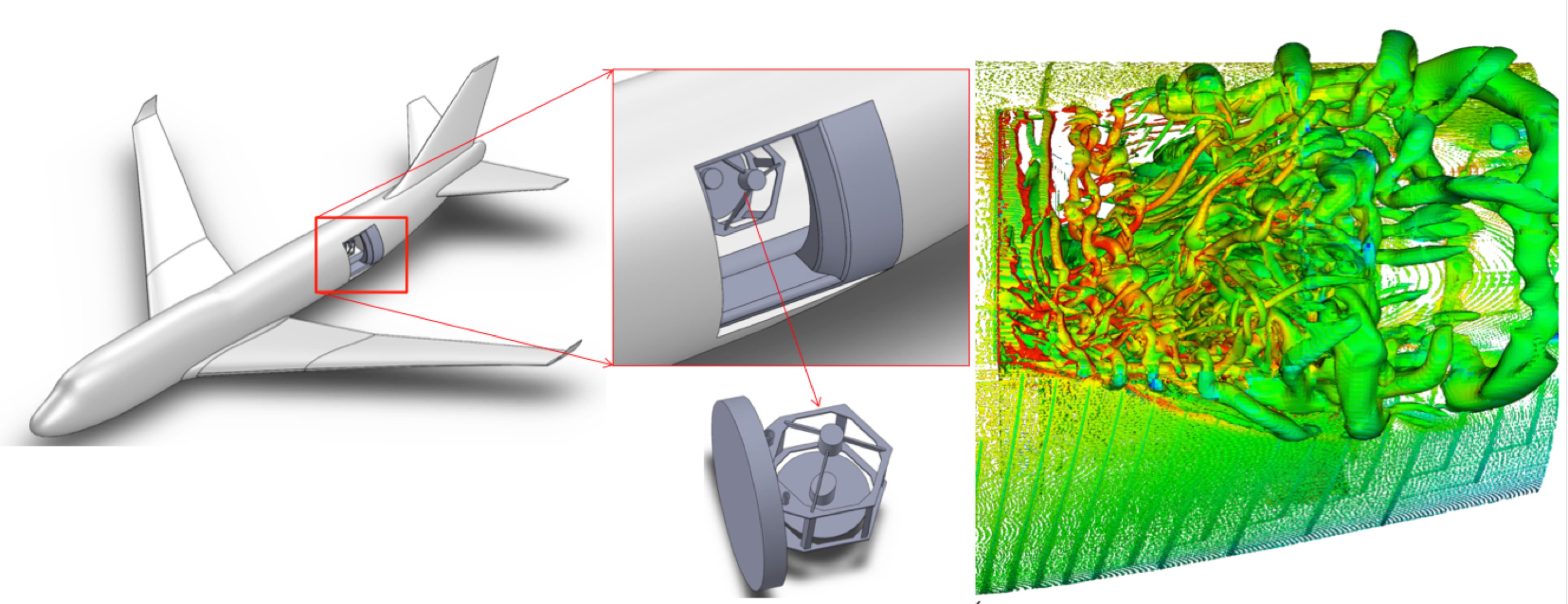Stephen Ammons (16-ERD-049)
Executive Summary
We are exploring the development of a conceptual design for an adaptive-optics system that can compensate for the deep, rapidly flowing turbulence around aircraft-mounted lasers and telescopes that degrades both imaging and beam propagation. This research has applications to laser communications, astronomical imaging, and remote-sensing systems.
Project Description
High-speed turbulent airflow—such as exists around a high-speed aircraft or in a gas-cooled, high-power laser gain cell—generates rapid, fine-scale density and index fluctuations that dramatically degrade both imaging and beam propagation. This turbulent airflow remains a vexing challenge in high-power laser propagation, laser communications, and astronomical imaging. In short, it is a key technical barrier. If resolved, breakthroughs would occur in laboratory-based, high-average-power laser systems, as well as aircraft-based, directed-energy weapons systems. Optical communication systems, intelligence, surveillance, and reconnaissance systems would also benefit. Traditional approaches have not led to significant progress; therefore, we are exploring the use of adaptive optics (AO) to compensate for deep, rapidly flowing turbulence in aircraft-mounted lasers and telescopes. We are developing (1) a conceptual design for a predictive AO system (2) an ensemble of computational fluid dynamics models spanning the above applications, and (3) a set of requirements for subsystems.
The broader impact of this work is rooted in the wide applicability of AO techniques beyond laser propagation. The system architectures we define may be directly applied to aircraft-based imagers and active remote-sensing systems, air-to-air and air-to-ground laser communication systems in the supersonic environment regime, and lasers for spacecraft propulsion. The research we conduct will have fundamental relevance for AO on extremely large telescopes and biological imaging through living tissue—both of which involve three-dimensional distortion media necessitating tomographic, multi-beacon, wave-front sensing.
We expect to provide a physics-based assessment of the viability and cost of using modern AO techniques and algorithms to compensate for deep turbulence effects on laser projection and imaging from aircraft, with the goal of improving irradiance on target by a factor of 10 over previous attempts. The research will proceed through three phases. The first—a definition phase—will involve selecting the most promising application scenarios, setting boundaries on geometric constraints such as altitude, flow speed, and turret design, and defining top-level performance requirements. During this phase, we will also develop a computational fluid dynamics model of the boundary-layer turbulence for each scenario. In the second phase, we will advance the subsystems, predictive algorithms, and integrated systems to the conceptual design level, with basic verification that the wave-front error budget is practical. We expect to (1) model the boundary-layer turbulence with high fidelity, incorporating state-of-the-art turret design; (2) perform a conceptual design study and simulation of the AO system, incorporating these models; and (3) derive subsystem requirements from the resulting performance metrics. In the final phase, we will construct an adaptive optics testbed incorporating improvements and leveraging progress in AO algorithms and methods developed for Livermore’s Gemini Planet Imager. Armed with real-world data and an experienced team, we will be prepared to field fully engineered design studies for laser-propagation systems in aircraft. The team will also be positioned to design similar AO architectures for astronomical systems—including AO and other tomographic systems for astronomical observatories.
Mission Relevance
Stable imaging and laser propagation through deep turbulence are important for a range of applications in astronomy, communications, and the remote sensing systems used for material detection and assessments of treaty compliance. Thus, this research supports the Laboratory’s national security mission and the NNSA goals of reducing nuclear dangers by providing operational capabilities for counterterrorism and counterproliferation, domestically and internationally. Our research also enhances the Laboratory’s core competency in lasers and optical science and technology. This project also leverages the Laboratory’s high-performance computing, simulation, and data science capabilities to understand supersonic turbulent flow in aerospace systems.
FY17 Accomplishments and Results
In FY17, we demonstrated the conceptual feasibility of correcting high-speed turbulent flow using predictive AO. Specifically, we (1) engineered a CAD model podded turret; (2) developed an ensemble of computational fluid dynamics models of the turret, including an open cavity in a Boeing 747 aircraft and a Stratospheric Observatory for Infrared Astronomy (SOFIA) configuration of an optical apparatus (see figure); (3) compared simulated turbulence strength with measured SOFIA data; (4) performed a conceptual design study of an AO system based on wavefront reference sources, correcting the resulting turbulence; (5) simulated the AO system, incorporating predictive control and vibration suppression algorithms; and (6) revised top-level system requirements and conducted an overall feasibility and cost assessment of the architecture.
   






